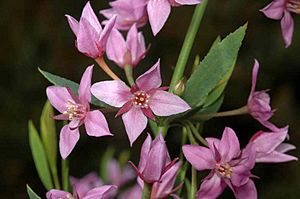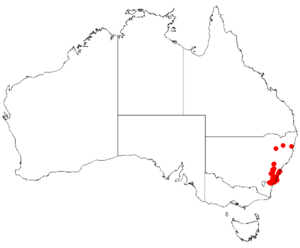Barker's boronia facts for kids
Quick facts for kids Barker's boronia |
|
|---|---|
 |
|
| Boronia barkeriana subsp. angustifolia in the Australian National Botanic Gardens | |
| Scientific classification | |
 |
|
| Occurrence data from Australasian Virtual Herbarium |
Boronia barkeriana, also known as Barker's boronia, is a special plant. It belongs to the citrus family, called Rutaceae. This plant only grows naturally in eastern Australia, meaning it is endemic there.
It is a type of shrub with branches that spread out close to the ground. Its leaves are simple and have small teeth along their edges. One of its most beautiful features is its bright pink flowers, each with four petals.
Contents
What Does Barker's Boronia Look Like?
Barker's boronia is a shrub that can grow between 0.2 and 1 meter (about 0.7 to 3.3 feet) tall. Its stems are smooth and often have a reddish color.
Leaves of the Plant
The leaves are simple and shaped like a narrow spear or egg. They are usually 10 to 33 millimeters (about 0.4 to 1.3 inches) long. They are also 2 to 10 millimeters (about 0.08 to 0.4 inches) wide. These leaves usually do not have a stalk connecting them to the stem. You might notice small teeth on the leaf edges. The edges and undersides of the leaves are often reddish.
Flowers of Barker's Boronia
The flowers are a bright pink or pinkish-purple color. They grow in groups of two to eight in the leaf axils. An axil is the angle between a leaf and the stem. Each flower sits on a small stalk called a pedicel, which is 4 to 18 millimeters (about 0.16 to 0.7 inches) long.
Flower Parts
The plant has four purple, triangular, or egg-shaped sepals. Sepals are like small leaves that protect the flower bud. They are about 1.5 to 8 millimeters (0.06 to 0.3 inches) long. The four petals are 5 to 11 millimeters (0.2 to 0.4 inches) long. Their bases overlap, making the flower look full. Inside, there are eight stamens, which are the parts that produce pollen. These stamens have hairy edges.
When Does it Flower?
Barker's boronia mostly flowers from September to December. After flowering, it produces small, smooth fruits. These fruits are about 4 millimeters (0.16 inches) long and 2 millimeters (0.08 inches) wide.
How Was Barker's Boronia Named?
The plant Boronia barkeriana was first officially described in 1880. This means it was formally identified and given its scientific name. The person who described it was a famous botanist named Ferdinand von Mueller. He published his description in a book called Fragmenta phytographiae Australiae. The plant was found by "Mrs. C.A. Barker" near Mount Wilson, New South Wales. This is why it was named barkeriana.
Different Types of Barker's Boronia
There are three slightly different types, or subspecies, of Barker's boronia:
- Boronia barkeriana subsp. angustifolia: This type has egg-shaped sepals that are more than 3 millimeters (0.12 inches) wide. Its leaves are 12 to 23 millimeters (0.47 to 0.9 inches) long and 4 to 9 millimeters (0.16 to 0.35 inches) wide.
- Boronia barkeriana subsp. barkeriana: This type has triangular sepals that are 1.5 to 3 millimeters (0.06 to 0.12 inches) wide. Its leaves are 16 to 30 millimeters (0.63 to 1.2 inches) long and 4 to 11 millimeters (0.16 to 0.43 inches) wide.
- Boronia barkeriana subsp. gymnopetala: This type also has triangular sepals 1.5 to 3 millimeters (0.06 to 0.12 inches) wide. Its leaves are 15 to 33 millimeters (0.59 to 1.3 inches) long and 1.5 to 6.5 millimeters (0.06 to 0.26 inches) wide.
Where Does Barker's Boronia Grow?
This boronia plant prefers to grow in damp areas, especially on sandstone.
Locations of Subspecies
- Subspecies angustifolia is mostly found in Morton and Budderoo National Parks.
- Subspecies barkeriana grows along the coast and in the ranges near Braidwood.
- Subspecies gymnopetala was only known from the area between Port Jackson and Waterfall. Sadly, it has not been seen since 1923, so it is thought to be extinct.

